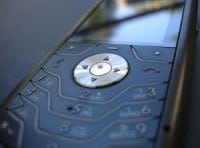
NANO-VIRUS DISSOLVES PHONES

'Phone flu' makes screens go blank, then turn into silver slime
- Dateline
- 12 December 2016
A new nano-virus, thought to have been spawned by genetic modification of bacteria for industrial manufacturing, has had an unfortunate spin-off. It causes the display screen of most phones to become opaque and gradually dissolve, bit by bit.
This is similar to the ‘grey goo’ threat of nano-technology, but doesn’t seem to affect other devices or people.
Unfortunately the flu is easily passed by touch from phone to phone, and users are advised to protect their phones with a see-through latex skin – a sort of condom for phones.
Teenagers are the worst affected – they can’t live without their phones for more than a few minutes, and seeing their ‘special friend’ dissolve into a puddle of silver metallic liquid has caused several adolescents to have anxiety attacks and nervous breakdowns!
Strangely enough, this new infection has encouraged teens to stay at home more, and avoid casual contact with one-night-stands, for fear of passing on the virus. Of course, those that stay in spend hours on the phone with their friends, engaged in virtual parties and cyber-dating.
ANALYSIS >> SYNTHESIS: How this scenario came to be
Viruses are usually passed between members of the same species, or like bird flu, can even be transmitted from one species to another. Computer viruses also replicate themselves, and seek to spread by ‘infecting’ other devices after connecting to them.
As the distinction between smartphones and computers becomes blurred, we see more opportunity for viruses to move from one system to the other. In the same way, as bio-chips and wireless devices become more closely integrated into the human body, the scenario exists for a programmed virus to infect people.
A new twist is the ability of a human to infect a machine. In the same way that human touch can contaminate sensitive electronic equipment, microbes or nano-particles might be passed by touch to susceptible devices, with unfortunate results!
Organic light emitting diode (OLED) displays are great for phones and portable devices, because they are bright, colorful and use little power. But being organic, they have a limited lifespan, although this has been boosted to 50,000 hours by recent improvements. If the organisms in OLED displays become contaminated with an anti-microbial compound such as nanosilver, or an exotic strain of bacteria, they would die off prematurely, leaving one with a dull blank screen, or worse, oozing grey goo.
So, you can use my phone, as long as you don’t have ‘the flu’.
Links to related stories
- MindBullet: NANOTECH - THE NEW FRANKENSTEIN (Dateline: 12 February 2009, Published: 19 August 2004)
- MindBullet: COMPUTER VIRUS INFECTS HUMANS (Dateline 13 February 2022, Published 7 October 2004)
- MindBullet: SPAMMED OR SCAMMED? BLAME THE PRESIDENT (Dateline: 1 January 2007, Published: 29 December 2005)
- MindBullet: GROW YOUR OWN PHONE OR PLAYSTATION (Dateline: 3 April 2021, Published: 17 March 2005)
- Grey goo - From Wikipedia, the free encyclopedia
- The dulling of nanotech’s silver lining - The Economist 1 December 2006
Warning: Hazardous thinking at work
Despite appearances to the contrary, Futureworld cannot and does not predict the future. Our Mindbullets scenarios are fictitious and designed purely to explore possible futures, challenge and stimulate strategic thinking. Use these at your own risk. Any reference to actual people, entities or events is entirely allegorical. Copyright Futureworld International Limited. Reproduction or distribution permitted only with recognition of Copyright and the inclusion of this disclaimer.